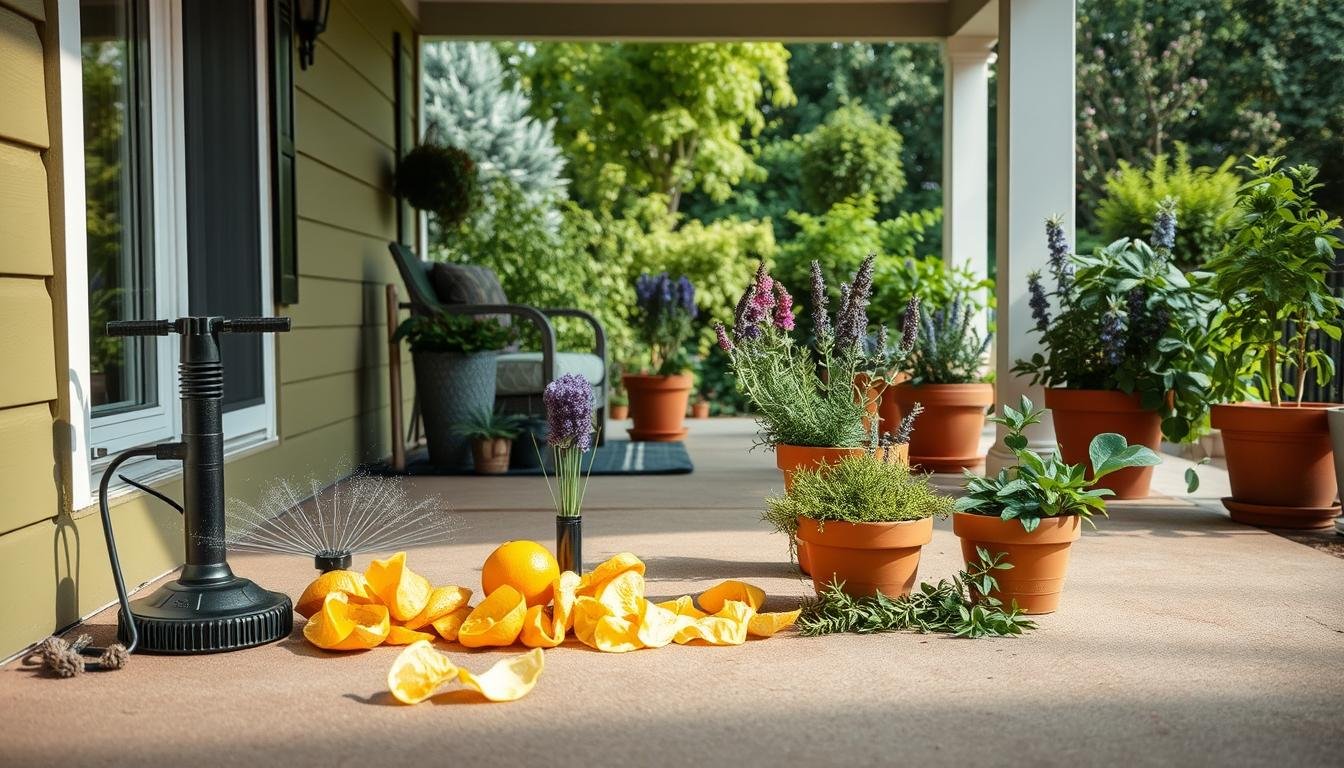If you’ve noticed more cats on your porch lately, you’re not the only one. With over 25% of households in the U.S. owning at least one cat, it’s likely a curious kitty might find its way to your space. Your porch is warm and sheltered, which cats love, but it can be annoying when they make a mess or disrupt your peace.
Luckily, there are humane ways to keep cats off your porch. By knowing what draws them and using certain deterrents, you can keep your porch cat-free.
Key Takeaways
- Cats are attracted to warm and sheltered spaces, making porches appealing.
- Natural cat repellents like lavender and citrus can help prevent cats from entering.
- Sticky textures, such as double-sided tape, can discourage cats from approaching.
- Using ultrasonic devices and other commercial cat repellents offer effective alternatives.
- Regular maintenance and observation are key in keeping your porch cat-free.
Understanding Why Cats Visit Your Porch
Your porch is like a cozy shelter for cats, protecting them from bad weather. It feels safe, which is a big reason cats come to porches a lot. They might also come looking for food like bugs or trash around your porch.
It’s essential to know about cat behavior. Feral cats, or community cats, think of your porch as their space. This is because it gives them shelter and food. This idea is similar to animal territory behavior, where cats pick places that help them survive.
Cats also look for places where they can be safe and relax away from predators and bad weather. So, your porch is perfect for them. It offers shelter they really need. Understanding this can help you find ways to keep cats off your porch.
Also, trying to get rid of cats usually makes other cats take their place. This is called the Vacuum Effect. That’s why it’s better to use kind methods like Trap-Neuter-Return (TNR). TNR involves spaying or neutering the cats and then putting them back. This method helps control the cat population and stops them from coming to your porch as much.
Effective Deterrents for Cats
In the United States, over 25% of homes have at least one cat. It’s important to know how to keep cats off your porch. Luckily, there are many safe cat deterrents and humane cat repellents that won’t hurt the cats.
Cats love warm spots and the sun, so outdoor furniture often becomes their go-to spot. Cat hair and claw marks can make cleaning hard and damage furniture. To avoid this, using deterrents regularly is key.
Cats have a strong sense of smell, with up to 200 million odor receptors. Scents like lavender, cinnamon, and vinegar can keep cats away. Also, planting rue and rosemary near your porch helps.
Physical barriers work well too. Cats hate the feel of sticky double-sided tape on their paws. Placing strips on furniture stops them without covering everything. Also, chicken wire, spiked mats, or natural textures like pine cones and eggshells discourage cats from lounging and digging.
There are also high-tech commercial products. The “SsssCat!” device sprays a safe mist when it detects motion, covering up to 3 feet. “Cat Stop” uses sounds cats don’t like to keep them away. And motion-activated sprinklers teach cats to stay away from your yard.
Here are some popular humane cat repellents and how to use them:
| Repellent | Type | Application |
|---|---|---|
| Lavender, Cinnamon & Vinegar Spray | Scent-Based | Spray around patio and garden areas |
| Double-Sided Tape | Physical Barrier | Apply to furniture surfaces |
| SsssCat! | Motion-Activated Spray | Set device to spray non-toxic repellent |
| Cat Stop | Electronic Deterrent | Place device in targeted areas |
| ScareCrow Sprinkler | Water-Based | Install in the garden or yard |
| Pine Cones & Eggshells | Physical Barrier | Spread in garden beds |
Being consistent with cat deterrents is crucial. If you’re not consistent, cats will keep trying. Combine different methods to keep your porch cat-free in a kind way.
Designing a Cat-Unfriendly Space
To make a space cats don’t like, you should start by arranging your porch carefully. A key step in designing landscapes to deter cats involves making your yard less appealing. You can do this by blocking places where cats might find shelter. This might mean adding barriers around your porch or choosing furniture that doesn’t offer cats a place to hide.
Using materials like pine cones or thick mulches can also keep cats away from your porch. These textures are not comfortable for cats to walk on. They’re useful in your plan to cat-proof your porch.
Tables can show different ways to keep cats away and how they stack up against each other. Below is a detailed look at some common tactics and their pros and cons.
| Method | Pros | Cons |
|---|---|---|
| Furniture Arrangement | Reduces sheltered areas for cats | May affect the aesthetic of your porch |
| Rough-Textured Materials | Makes it uncomfortable for cats | Maintenance and cost |
| Scent Repellents | Natural and can be homemade | Requires regular reapplication |
Making your porch cat-proof requires a mix of strategies. Combining well-placed furniture with the right materials can make your porch uninviting to cats. Keeping an eye on your porch and upkeeping your strategies ensures they keep working over time.
Utilizing Sound and Motion
To keep cats off your porch without harm, try sound and motion techniques. Use motion-activated deterrents to safely scare them away. For example, motion-activated sprinklers shoot out water suddenly. Cats don’t like this and will learn to stay away.
Ultrasonic devices are also great. They send out high sounds that bother cats but we can’t hear. Devices like the Bird-X Yard Gard can cover big areas, up to 4,000 square feet. So, they protect a lot of space. Usually, stubborn cats start to stay away after 1 to 2 weeks. Moving these devices around stops cats from getting used to them.
Using these sound and motion tricks means you don’t have to use bad chemicals or fences. Many pet lovers prefer this gentle way. Motion-activated sprinklers and ultrasonic devices help control cats kindly and well.
Engaging with Your Cat Neighbors
Talking with your neighbors about communicating about cats can lead to peace. Working together often solves neighborhood animal issues. By discussing your worries and hearing others, you might find solutions that work for everyone.
Chat about the right way to feed cats. Feeding them wrong can bring more cats to your area. This may increase their visits to your porch. Encouraging neighbors to feed cats in certain spots or at set times can help.
Getting neighbors to join spay/neuter efforts can lower the number of local cats. This means fewer cats will visit your porch. These actions also help control the overall number of strays, improving neighborhood animal management.
- Establish regular meetings: Organize gatherings to talk about cat issues and share solutions.
- Set up a communal feeding schedule: This makes the cats roam less, avoiding your porch as a feeding spot.
- Participate in local wildlife groups: Be part of groups that manage local animals and share how to deal with roaming cats.
- Spread awareness of deterrents: Tell your neighbors about things like citrus peels or homemade sprays to keep cats away.
Talking more not only tackles the issue but also brings the neighborhood together. By collaborating, you and your neighbors can live peacefully with the cats, making your porch less inviting to them.
Regular Maintenance and Observation
Keeping your porch free of cats requires ongoing care. It’s key to maintain the deterrents you’re using. This includes checking and replacing worn items, whether they’re motion-activated devices, repellents, or visual barriers. Keeping these items in good condition helps your efforts stay strong. The Journal of Applied Animal Behavior Science says motion-activated devices are very effective but must be checked and moved occasionally to work well.
It’s also crucial to watch how well your cat deterrents work. By regularly looking at your porch, you can see if cats keep coming back or if something new attracts them. The American Society for the Prevention of Cruelty to Animals (ASPCA) suggests using positive methods, like treats, to train cats to stay away. By keeping an eye on things, you can adjust your approach to keep your porch cat-free.
Maintenance isn’t just about keeping deterrents in shape. You also need to make sure your porch isn’t inviting to cats. Keep it clean from food scraps, seal trash cans tightly, and reduce cozy spots for cats. PetMD notes that sticking with these steps is crucial for success. By fine-tuning your methods, you can enjoy a porch without the company of cats.




